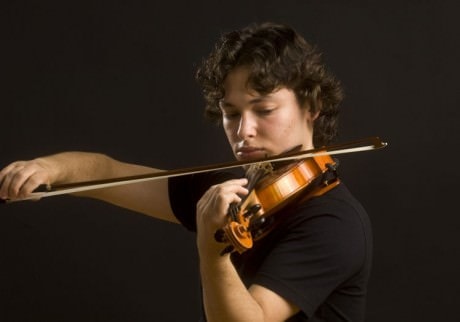Challenging or dissonant music can be a slog for both the classical music performer and the listener. If you’re at all fearful to see live concerts because of the reputation of 20th-century “serious” music and you need a master interpreter to turn it into something intelligible and powerful, have I got the (young) man for you.

Yevgeny Kutik is a fast-rising American violinist in his late twenties who is building a reputation based on his championing of Soviet-era Russian composers and two of the most intriguing initial CD releases by a new classical artist in some time. Performing on Saturday night in New York, Mr. Kutik delivered an exceptionally meaty program combining some of the most abstract with some of the most openly emotional of Russian and French violin music of the late 19th though mid-20th centuries.
The keynotes of the two halves of the program were large-scale sonatas for violin and piano by French composer Cesar Franck and Russian composer Sergei Prokofiev. In particular, Prokofiev’s Violin Sonata #1 in F minor demonstrated the wellsprings of Soviet-era angst among artists and intellectuals under a brilliant interpretation by Mr. Kutik.
Prokofiev composed the work after returning from Paris to the Soviet Union in the mid-1930s, only to find that colleagues he had known 15 to 20 years earlier had “disappeared.” Sometime during the period of 1938 to 1946 that it actually took him to finish the sonata, he inserted a striking if ultimately morbid effect at several points that has the violinist racing up and down the instrument in a variety of scales and modes but doing so extremely softly against a murmuring piano background.
Prokofiev directed the violinist who debuted the piece to make the line “like wind passing through a graveyard.” Thus the performer must not so much draw his bow with a conventional light touch but must manipulate how the bow actually sits on the string so that it sounds ethereal and coming from a distance – a difficult move to execute without making the instrument squeak like fingernails on a chalkboard. Perfectly executed by Mr. Kutik, he left the audience mesmerized and perhaps a little scared in musing on Stalin’s reign of terror, especially since Mr. Kutik had verbally described what was going to happen, and why, before he played the piece.
In pulling off this and other effects during the sonata, including many contrasting raucous passages, Mr. Kutik had two things going for him. The first is the particular tone he produces on the violin. He has a fast-developing vibrato that nevertheless remains relatively tight (in plain English, it starts quickly but doesn’t wobble that much). This immediate touch of warmth means that even when directed to attack the instrument in brusque passages, the notes remain identifiable and pleasurable, something I can’t say about even some top-rank violinists.
The other thing is Mr. Kutik’s own biography. In 1990, when he was 5 years old, his family emigrated from Minsk, Belarus – in what was then still the Soviet Union – to the United States. Although his family could carry only two suitcases, his mother had insisted in filling part of one with a collection of musical scores, including some music by virtually unknown contemporary Russian composers. Over the years as Yevgeny studied violin first with his mother and then with outside teachers, Yevgeny picked up this music and began exploring it. Some of it informed his first album in 2012 called Sounds of Defiance, which explores the way well-known and little-known Soviet composers managed to insert “protest music” into their officially sanctioned compositions. But these manuscripts are the entire focus of his 2014 album, Music from the Suitcase, which has become something of a minor sensation, illustrated in this interview with NPR’s Robert Siegel last spring.
This connection between Yevgeny’s childhood history and the composers he promotes brings immediacy to the interpretations he delivers. Both in Music from the Suitcase and in New York, Mr. Kutik performed a waltz from Prokofiev’s ballet suite Cinderella which inserts a surprising, and disturbing, middle section that relates directly to Cinderella’s rough treatment at the hands of her family and society (and can be analogized further to many different things based on its composition in 1940).
In Saturday night’s concert this piece followed a relative interlude provided by the four-movement sonata by the French composer Franck, which has a unique, and in this case joyful, innovation of its own. It’s a set of passages where the solo violin imitates a melody introduced by the “accompanying” piano by playing exactly one bar behind the piano for many measures on end. How this music magically holds together despite the “lagging” violin is something I’m dying to explore with the score!

Rounding out the program were two suites representing yet other parts of Eastern European society. One was a set of Hungarian Tunes found in the Kutik family’s now-famous suitcase by a still-living composer named Andrei Eshpai, who Yevgeny identifies as a member of a Russian gypsy or indigenous people. The other was a suite of Three Pictures of Chassidic Life representing the part of Eastern European Jewish life that was more openly emotionally charged rather than inward and intellectual, set by Ernest Bloch, who was known (among other things) for his settings of Jewish liturgy, some of which are still in use today.
Throughout these pieces, little tricks like the violin and piano playing a half-tone apart before rejoining each other – or the violin stroking two adjacent clashing notes before releasing one to rejoin a key that the piano was exploring – suffused the music with spiciness. As Mr. Kutik’s accompanist, pianist Anna Polonsky carried an unusually elegant style that restrained the Steinway concert grand at the concert venue – Washington Irving High School in the Gramercy district near Greenwich Village – from overwhelming the solo violin, even in some fairly wild piano writing by both Franck and Prokofiev.
As a matter of disclosure, I met Yevgeny Kutik the last time he performed in Washington, in an all-Tchaikovsky concert at the Russian Embassy for the benefit of the Heifetz International Music Institute in April 2013. The Heifetz Institute, running every summer at Mary Baldwin College in Staunton, Virginia, trains talented young musicians in exactly what Yevgeny has succeeded in – communicative immediacy with the audience as well as technical prowess. Following his trajectory should be as rewarding for anyone as it has been for me.
As for Saturday night, Mr. Kutik’s concert was part of a remarkable series that has been around for over a century in New York but is probably little known outside of the city called the “Peoples’ Symphony Concerts.” Bringing both new and veteran soloists – later in the season long-prominent pianist Emanuel Ax is playing a concert in the series – for the almost unheard-of price in Manhattan of $15 a ticket, the “Peoples’ Symphony” (which for the most part doesn’t really present “symphonies” but the name has stuck) is a gem of the New York live classical music scene. I’d suggest it’s a wonderful accompaniment to any theater trip to Manhattan. Especially if all the concerts are like this one.
Running Time: 2 hours and 5 minutes, with one 20-minute intermission.
Violinist Yevgeny Kutik performed in the Peoples’ Symphony Concerts on Saturday, November 15, 2014, at Washington Irving High School-40 Irving Place, in New York City. For information about upcoming concerts in the Peoples’ Symphony series, see their schedule. For Yevgeny Kutik’s upcoming concert schedule, see his concert calendar and website.




